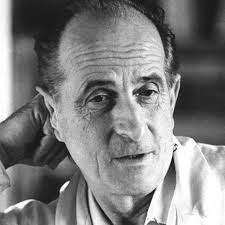赫鲁伯 Miroslav Holub (米洛斯拉夫·赫鲁伯)
20200710
注解: 手指向下或右滑,翻到下一页,向上或左滑,到上一页。
赫鲁伯

简介
捷克医学家诗人米洛斯拉夫·赫鲁伯(Miroslav Holub,1923.9.13-1998.7.14)捷克著名诗人、作家,同时他是布拉格医学院一位著名的免疫学专家。1923年,他出生于捷克西波西米亚(Western Bohemia)的普勒扎(Plzen),父亲是一名律师,母亲是一名中学的德文和法文教师,从小赫鲁伯就深深地受到了母亲的影响。在二战结束之后,也就是他三十多岁的时候,开始写作,并同时在医学上有所建树。
在他人生的最后30年里,他在诗歌领域和医学领域同时获得了很高的成就。他成为一位世界范围内享有声誉的免疫学专家,1967年,他的第一本英文诗集出版,从此他的诗作引起了世界的好奇,在大西洋两岸颇有反响,曾经获得意大利费拉亚诺(Flaian o)诗歌奖(中国诗人杨炼曾经在1999年获得该奖项)。
赫鲁伯一生发表超过140篇科学论文,出版3本科学专著,出版了14本诗集,5本散文集。在西方,他和以色列诗人阿米亥(Yehuda Amichai,1924-2000)、波兰诗人赫伯特(Zbigniew Herbert,1924-)并称“二十世纪后半叶最具影响力的三大诗人”。曾经一段时期,因为受到政治迫害,他的随笔只能匿名在国内报刊上发表,不过即便这样,他独特的风格还是被细心的读者辨认了出来。
(1923–1998)
a mathematics with blood in it.
Paul Breslin, Poetry
Miroslav Holub was born in 1923 in what was then known as Czechoslovakia. He worked as an immunologist at the Microbiological Institute of the Czechoslovak Academy of Science, receiving his PhD in 1958.
His poetry was heavily influenced by his work as an immunologist – a profession he continued even after he received international acclaim for his poetry. The editors of Modern Poetry in Translation No.1 state that Holub described ‘his poetry as “the exact parallel” of his scientific work.’
Although he was not published in his homeland until after the fall of Communism, by the 1970s his writing was well-known in English, and his books had been translated into over thirty different languages. He was described by Ted Hughes in 1988 as ‘one of the half dozen most important poets writing anywhere’.
His poem ‘The fly’ is especially well known in English. George Theiner’s translation, published in Modern Poetry in Translation No.1, was considered very important, and in 2000 it was even included in the New Penguin Book of English Verse.
This poem highlights the scientific imagination at work in his poetry, telling the tale of a fly at the Battle of Crécy, alighting on human and animal corpses. The brutality of war is rendered with realist detail, contrary to the romantic descriptions of knighthood and chivalric warfare one might perhaps expect from the historical subject matter. As it follows the movements of the fly, the poem examines the aftermath of violence with distance and detailed indifference:
She rubbed her legs together
as she sat on a disembowelled horse
meditating
on the immortality of flies.
and later in the poem, we are told:
she began to lay her eggs
on the single eye
of Johann Uhr,
the Royal Armourer.
At the end of the poem, the fly itself is eaten by a swift ‘fleeing | from the fires of Estrées’.
Modern Poetry in Translation No.1 carries a large selection of Holub’s poems – more than any other poet in the issue, all in translations by fellow Czech, George Theiner.
Seamus Heaney described his writing as ‘a laying bare of things, not so much the skull beneath the skin, more the brain beneath the skull; the shape of relationships, politics, history; the rhythms of affections and disaffection; the ebb and flow of faith, hope, violence, art’.